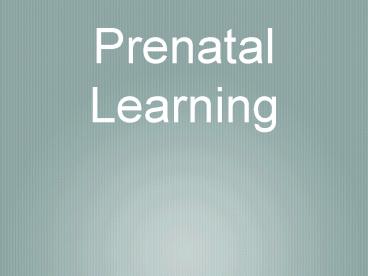Prenatal Learning - PowerPoint PPT Presentation
1 / 24
Title:
Prenatal Learning
Description:
Solid line is expression pressure and dotted line is sucking pressure. Sucking frequency and expression pressure are greater with mother's odor ... – PowerPoint PPT presentation
Number of Views:77
Avg rating:3.0/5.0
Title: Prenatal Learning
1
Prenatal Learning
2
Basic Issues
- How can we tell that the fetus can learn?
- Experimental Methodology
- What type of information might the fetus learn?
- How specific is that learning?
3
How do we tell?
- Need to provide unique experience to infant in
utero - Test to see if fetus responds to unique
experience - Test to see if postnatal infant retains the
information exposed to in utero
4
Novelty-Preference
- Preset number of Familiarization Trials
- Present 2 Stimuli at Test - Novel Familiar
- Compare Test Performance of Each Stimulus to the
Other
5
Type of Information
- Auditory
- Mostly from mom
- But some from other
- Need to make sure not drowned out by the moms
heartbeat and placental noises - Taste and smell
- Material in amniotic fluid
6
Early Findings
- Infants will suck a pacifier to hear their
mothers voice over a strangers voice (DeCasper
Fifer, 1980) - Infants, whose mother read Cat in the Hat twice a
day during last 6 weeks of pregnancy, sucked to
hear Cat in the Hat over The King, the Mice and
the Cheese (DeCasper Spence, 1986). - Subsequent studies indicated that it was not the
specific words of story that were learned by the
fetus but the prosody (or rhythym).
7
DeCasper et al. (1994)
- Similar to Cat in the Hat study
- Pregnant women read one of two childs rhymes
- Fetuses were tested 4 weeks after the reading
began - Tested with both rhymes read by a stranger
- Measured heart rate of fetuses
8
Attention HR Richards (1988, 1991)
- Richards found that during attention-holding,
which he called sustained attention, heart-rate
decelerated - Also found that infant is less likely to be
distracted by a second stimulus when in
heart-rate deceleration
Pre-Attention
Attention Termination
Orienting
Sustained Attention
9
DeCasper et al. (1994)
- Hearing the target rhyme elicited a decrease in
heart rate - Indicating attentive processing
- Suggests that fetuses learn and become familiar
with maternal speech sounds
10
Lecanuet et al. (2000)
- Interested in the fetus ability to discriminate
two musical notes (D4 vs. C5) - Measured heart rate change when notes are
presented
11
Lecanuet et al. (2000)
- Infants who discriminated the notes, showed HR
deceleration at the onset of each note - Around 70 and 90 showed HR deceleration to the
the first and second notes
12
Menella et al. (2001)
- Most of the psychological work on prenatal
learning has been concerned with auditory
information - However, fetuses get other types of sensory
experiences, including taste
13
Menella et al. (2001)
- Flavors of foods mom eats get into amniotic fluid
and is consequently tasted by fetus - Flavors similarly get into breast milk
- Had moms drink either carrot juice or water
during pregnancy and then switched them to the
other after birth - Once infants began eating cereal, tested infants
by mixing it with either water or carrot juice - Measured infants reaction and mothers ratings
14
Menella et al. (2001)
- These results indicate that infants exposed to
the carrot flavor, even prenatally, preferred
that taste than infants who did not
15
Mizuno Ueda (2004)
- The odors of foods mom eats also gets into
amniotic fluid - These odors may then be learned by the fetus and
subsequently affect breast feeding
16
Mizuno Ueda (2004)
- Numerous studies that newborns can recognize
their mothers odor at birth - Interested whether preferences for maternal odors
independent of postnatal experience play greater
role in olfactory learning
17
Mizuno Ueda (2004)
- Newborn infants were separated from mothers for
10 to 14 days postnatally - At test, infants given same formula with which
they had become familiar - But were presented with one of three odors
mothers milk, formula, or distilled water - Measured sucking pressure and frequency, and
sucking efficiency
18
Mizuno Ueda (2004)
- Solid line is expression pressure and dotted line
is sucking pressure - Sucking frequency and expression pressure are
greater with mothers odor
19
Mizuno Ueda (2004)
Sucking Pressure
Expression Pressure
Sucking Efficiency
Sucking Frequency
20
Mizuno Ueda (2004)
- Thus, infants preferred their mothers odor which
they had not experienced since they were in utero - Suggests that the odor learning is quite strong
in utero and carries more weight on infants
olfaction and feeding than does postnatal
experience
21
Take Home
- These studies that learning does occur by the
fetus in utero - The fetus can learn about sounds, tastes, and
odors - They retain this information even after they are
born
22
Take Home
- However, what they learn is limited
- Typically, information that will promote caring,
survival and attachment - Furthermore, claims of supreme benefits on IQ,
math ability and sociability of prenatal exposure
to information are completed unsubstantiated by
the research
23
Questions
- One study showed that prenatal exposure to the
mother's tongue can promote language-relevant
perceptual tuning before birth. Would prenatal
exposure to many languages provide an advantage
for learning these other languages? - If after a baby is born, the biological mother
and the newborn are separated due adoption or
death, will the newborn be delayed in terms of
language and speech because the new maternal
figure is not the same one that was stimulating
and speaking to them when they were still in the
uterus?
24
Questions
- How would researchers explain children who at
first do not like a certain food, but then learn
to like it later on. - Has there been any testing using fMRI to assess
changes in activation in brain areas that might
be affected by the prenatal exposure?































